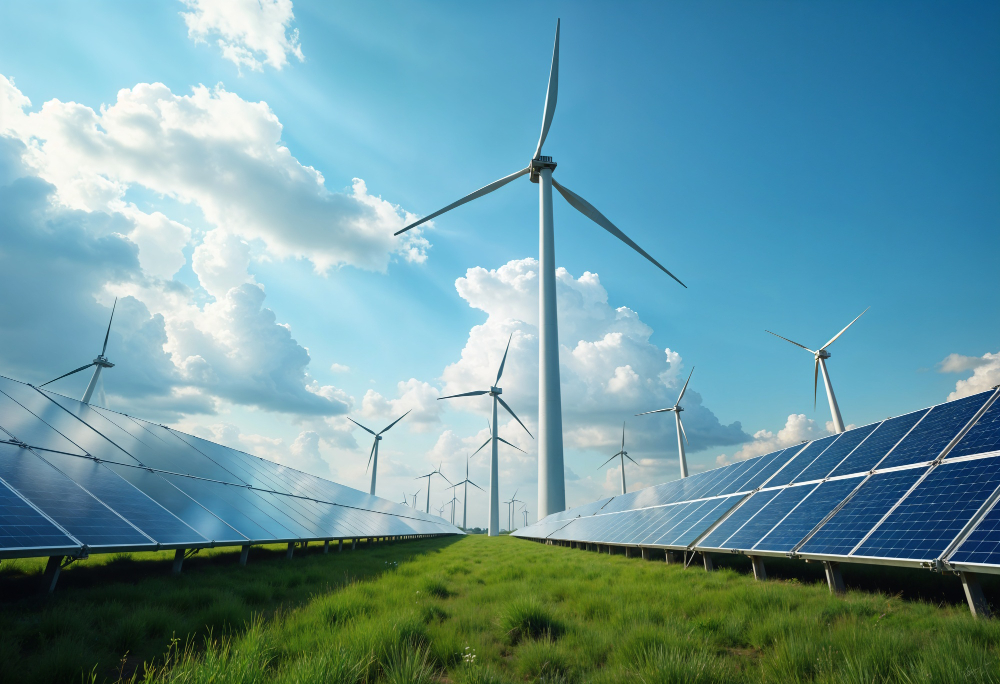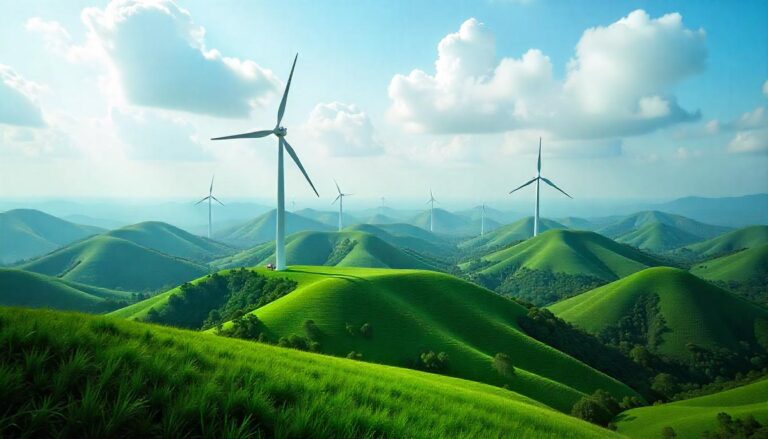Beyond the Green Glow: Unpacking the 4 Core Disadvantages of Renewable Energy

The global push towards a sustainable future has placed renewable energy at the forefront of our fight against climate change. With promises of clean power, reduced carbon emissions, and energy independence, technologies like solar and wind have rightly captured the public’s imagination. They are indeed indispensable for a decarbonized world.
However, to truly navigate the complexities of the energy transition, it’s crucial to move beyond the green glow and acknowledge a more nuanced reality. No energy source is without its inherent challenges and disadvantages, and renewables are no exception. Understanding these fundamental drawbacks of renewable energy isn’t about undermining their critical role; it’s about fostering a realistic perspective that enables smarter planning, accelerates innovation, and builds more resilient energy systems.
This article aims to provide a comprehensive and balanced overview, unpacking the 4 core disadvantages of renewable energy that demand our attention. From the unpredictability of nature to the hidden environmental costs, we’ll explore the complexities often overlooked in the race for a cleaner planet.
- 1. When the Sun Doesn’t Shine & the Wind Doesn’t Blow: The Intermittency Challenge
- 2. The Price Tag of Progress: High Upfront Costs and Aging Infrastructure Hurdles
- 3. Nature’s Gatekeepers: Why Renewable Energy Isn’t Universally Applicable
- 4. The Unseen Footprint: Environmental and Social Costs of ‘Clean’ Energy
- Conclusion: A Balanced Perspective Towards a Sustainable Future
- FAQs (Frequently Asked Questions)
- 1. Is renewable energy truly “clean” if it has environmental impacts?
- 2. How do we solve the problem of renewable energy’s intermittency?
- 3. Why are renewable energy projects still so expensive to build initially?
- 4. Can renewable energy power the entire world, given its geographical limitations?
- 5. What happens to old solar panels and wind turbine blades?
1. When the Sun Doesn’t Shine & the Wind Doesn’t Blow: The Intermittency Challenge
One of the most widely recognized disadvantages of renewable energy, particularly solar and wind, is their inherent intermittency and variability. Unlike traditional power plants that can generate electricity on demand, solar panels only produce power when the sun is out, and wind turbines spin only when the wind blows. This direct reliance on weather conditions and time of day creates significant clean energy challenges for grid operators.
- Grid Imbalance & Stability: Fluctuations in renewable output can lead to rapid shifts in electricity supply. Maintaining a stable grid requires a constant balance between generation and demand. When renewable output drops suddenly (e.g., a cloud passing over a solar farm, wind dying down), backup power sources must quickly ramp up to fill the void, or the grid risks instability, leading to brownouts or even blackouts. Historically, these backups have often been fast-ramping natural gas plants.
- Curtailment: Paradoxically, too much renewable energy can also be a problem. During periods of high resource availability (e.g., sunny midday with low demand), excess power generated by renewables may have to be “curtailed” or shut down. This wastes clean energy that could have been used, incurring financial losses for generators.
- Forecasting Difficulties: While meteorological forecasting has improved, predicting the exact output of thousands of distributed solar panels or fluctuating wind farms across a vast region remains incredibly complex. This unpredictability complicates long-term planning and real-time grid management.
- The “Duck Curve”: A classic illustration of solar intermittency’s impact, the “duck curve” shows how high solar penetration creates a significant dip in net demand during the day, followed by a sharp ramp-up requirement in the late afternoon/early evening as solar output declines and electricity demand rises. This steep ramp often necessitates quick-start fossil fuel plants.
Mitigation and Ongoing Challenges: Significant investment in energy storage solutions, particularly large-scale batteries, is crucial to address intermittency. While battery prices for grid-scale applications have fallen dramatically in recent years, the cost of battery storage for the grid remains substantial. For instance, achieving 12 hours of storage for 80% of US demand could cost $2.5 trillion. However, global battery storage capacity is projected to reach 270 GWh by the end of 2025, and advancements in AI and IoT are increasingly being used to optimize grid management and forecasting, as seen in Germany’s projections for reduced grid management measures in winter 2025/2026. Despite these efforts, ensuring a truly reliable grid with high renewable penetration remains a complex engineering and economic puzzle.
2. The Price Tag of Progress: High Upfront Costs and Aging Infrastructure Hurdles
While renewable energy technologies often boast minimal operational costs (since there’s no fuel to buy), the initial cost of renewable energy infrastructure represents a significant renewable energy drawback. Building large-scale solar farms, wind parks, or geothermal plants requires substantial capital investment.
- High Initial Capital Expenditure (CAPEX): For utility-scale projects, the upfront costs can be immense. For instance, large-scale solar system installations can range around $2,000 per kilowatt. For wind power, upfront CAPEX can represent 70-80% of a project’s lifetime costs. Despite the Levelized Cost of Energy (LCOE) for new renewables often being lower than new fossil fuel plants over their lifespan, the initial financial outlay can still be a barrier for developers and investors, especially in regions with higher interest rates or perceived risks. Recent data indicates that due to elevated commodity prices and rising interest rates, LCOE for solar and wind in many markets remained 10-15% above 2020 levels in 2023-2024.
- Aging Infrastructure Mismatch: Much of the existing global electricity grid was designed for centralized power generation from large fossil fuel or nuclear plants. It’s ill-equipped to efficiently handle the decentralized, variable power flow from widespread renewable sources. This necessitates massive grid modernization investment.
- Transmission Bottlenecks: The most resource-rich areas for renewables (e.g., sunny deserts, consistently windy plains) are often far removed from major population centers where electricity demand is highest. Building new, long-distance transmission lines to connect these remote generation sites to urban grids is incredibly expensive (e.g., $2-4 million per mile) and often faces significant permitting and local opposition.
- Upgrade Costs: Governments and utilities face multi-trillion-dollar investments globally to upgrade and “smartify” grids, enabling them to integrate larger shares of renewable energy, manage two-way power flows, and enhance resilience. This massive financial undertaking is a major renewable energy economic drawback that falls on taxpayers and ratepayers.
3. Nature’s Gatekeepers: Why Renewable Energy Isn’t Universally Applicable
The effectiveness and even feasibility of certain renewable energy sources are profoundly dependent on specific natural and geographical conditions. This means that not every region can harness every type of renewable energy with equal efficiency, posing significant renewable energy problems for universal deployment.
- Solar Power: Most efficient in regions with abundant, consistent sunlight and low cloud cover. Areas at high latitudes or those experiencing prolonged cloudy seasons will have significantly lower solar energy yields, making large-scale solar farms less economically viable.
- Wind Energy: Requires consistently strong and stable wind speeds. While offshore wind offers vast potential due to stronger, more consistent winds, it comes with higher installation and maintenance costs. Onshore wind farms are limited by suitable wind profiles and land availability; urban areas, for instance, are generally unsuitable.
- Hydropower: Relies on specific river systems, significant elevation drops, and consistent water flow. Dam construction, while providing clean energy, also involves substantial environmental alteration, including habitat disruption and changes to local ecosystems.
- Geothermal Energy: Limited to regions with accessible geothermal reservoirs, typically found near volcanic activity or tectonic plate boundaries. This restricts its widespread adoption to only a few geologically active areas.
- Ocean/Tidal/Wave Energy: Highly localized to coastal areas with specific oceanographic conditions, still largely in the developmental or nascent commercialization stages.
These renewable energy geographic constraints mean that a diversified energy mix, often relying on international transmission, is crucial. For example, highly centralized data centers demand 24/7 power that weather-dependent renewables in urban areas simply cannot consistently provide, highlighting the need for energy sources suited to their specific location and operational demands. This uneven distribution of renewable potential can also exacerbate energy equity issues, as some regions are naturally better endowed than others.
4. The Unseen Footprint: Environmental and Social Costs of ‘Clean’ Energy
While renewable energy sources are lauded for their near-zero operational emissions, a holistic view reveals that their entire lifecycle—from manufacturing to disposal—carries an environmental and sometimes social footprint. It’s crucial to unpack these environmental impacts of renewable energy to ensure a truly sustainable transition.
- Manufacturing & Supply Chain Impacts:
- Energy-Intensive Production: The creation of components like solar panels (especially polysilicon), wind turbines, and batteries involves industrial processes that are themselves energy-intensive and often still powered by fossil fuels, contributing to emissions.
- Raw Material Extraction: Mining for critical minerals such as silicon, copper, lithium, cobalt, and rare earth minerals (like neodymium, crucial for high-efficiency wind turbine magnets) can lead to significant habitat destruction, water pollution, and resource depletion. The concentration of these supply chains (e.g., 79% of polysilicon capacity in China) also raises geopolitical and ethical concerns.
- Toxic Chemical Use: The manufacturing processes for some components, particularly solar panels, utilize hazardous chemicals that require stringent management to prevent environmental contamination.
- Land Use & Habitat Disruption:
- Large Footprint: Utility-scale solar and wind farms require vast tracts of land. Some analyses suggest large-scale renewables can demand up to 10 times more land than conventional fossil fuel power plants. This can lead to habitat loss, fragmentation, and direct impacts on biodiversity.
- Wildlife Impacts: While often localized, wind turbines can cause bird and bat fatalities, and large-scale solar installations can affect desert ecosystems. Hydroelectric dams drastically alter river ecosystems, impacting fish migration and aquatic biodiversity.
- End-of-Life & Waste Management Challenges:
- Recycling Difficulties: Solar panels, wind turbine blades (made of complex composite materials), and large-scale batteries are difficult and expensive to recycle effectively. Many still end up in landfills, creating a future waste management crisis. The lack of robust solar panel recycling challenges and wind turbine blade disposal solutions is a growing concern.
- Hazardous Materials: Some components contain hazardous materials that could leach into the environment if not properly disposed of, posing long-term risks.
- Social & Aesthetic Concerns:
- Visual and Noise Pollution: Large wind farms, in particular, can be seen as visually intrusive in natural landscapes. Wind turbines also generate noise that can be a nuisance for nearby residents.
- Local Opposition (NIMBY): Concerns over aesthetics, noise, property values, and perceived environmental changes often lead to “Not In My Backyard” (NIMBY) sentiment, which can significantly delay or even halt renewable energy project development. Research suggests that renewable energy development can lead to conflict and environmental injustice, particularly concerning land use and displacement of communities, if not handled equitably.
Conclusion: A Balanced Perspective Towards a Sustainable Future
The transition to renewable energy is not a simple, problem-free switch; it’s a complex, multi-faceted undertaking. By acknowledging the 4 core disadvantages of renewable energy—intermittency, high upfront costs, geographical limitations, and the full lifecycle’s environmental and social impacts—we can move beyond an idealized “green glow” and adopt a more realistic, robust approach.
Despite these significant renewable energy problems, the imperative for a sustainable future powered by clean energy remains paramount. Understanding these drawbacks is not a reason for inaction but rather a catalyst for targeted innovation, strategic planning, and responsible development. The industry is actively pursuing solutions: from ever-improving energy storage solutions and AI-driven grid optimization to advancements in recycling and sustainable sourcing.
By facing these clean energy challenges head-on with transparency and a commitment to continuous improvement, we can build a truly resilient, equitable, and sustainable energy system that benefits both people and the planet for generations to come.
What are your thoughts on these disadvantages of renewable energy? How do you think we can best overcome them to accelerate the renewable energy transition responsibly? Share your insights and solutions in the comments below!
FAQs (Frequently Asked Questions)
1. Is renewable energy truly “clean” if it has environmental impacts?
While renewable energy sources have near-zero operational emissions, their full lifecycle (mining, manufacturing, transportation, installation, and disposal) does have an environmental footprint. For example, manufacturing solar panels and batteries requires energy and raw material extraction, which can cause pollution and habitat disruption. However, their overall lifecycle impact is significantly lower than that of fossil fuels, particularly regarding greenhouse gas emissions.
2. How do we solve the problem of renewable energy’s intermittency?
Solving intermittency primarily involves energy storage solutions (like large-scale batteries), enhanced grid flexibility (e.g., smart grids, demand-side management), better weather forecasting, and a diverse mix of renewable energy sources that complement each other (e.g., solar and wind). Backup power, often from natural gas plants, is still used but is being phased out as storage and grid solutions advance.
3. Why are renewable energy projects still so expensive to build initially?
Renewable energy projects require significant upfront capital investment for infrastructure like solar panels, wind turbines, and associated grid connections. While the Levelized Cost of Energy (LCOE) for renewables has fallen, reflecting lower operational costs over a project’s lifespan, the initial CAPEX remains substantial. Factors like commodity prices, interest rates, and the need for extensive grid upgrades contribute to these high initial costs.
4. Can renewable energy power the entire world, given its geographical limitations?
Technically, yes, the Earth receives enough renewable resources (solar, wind) to power the world many times over. However, practical geographical limitations mean that not all regions are equally suitable for all types of renewables. Overcoming this requires vast investments in long-distance transmission infrastructure, advanced energy storage, and a global energy strategy that leverages each region’s most abundant renewable resources.
5. What happens to old solar panels and wind turbine blades?
Recycling solar panel recycling challenges and wind turbine blade disposal are growing concerns. Solar panels contain valuable materials like silicon and aluminum but also some hazardous ones, making recycling complex and costly. Wind turbine blades are typically made from fiberglass composites, which are difficult to break down and recycle economically, often leading to them ending up in landfills. However, research and new circular economy initiatives are actively exploring more sustainable end-of-life solutions.



